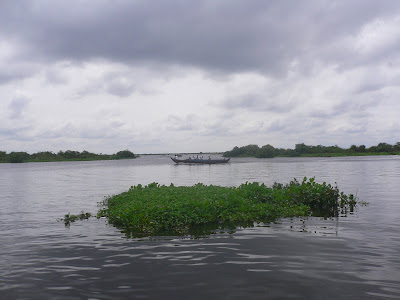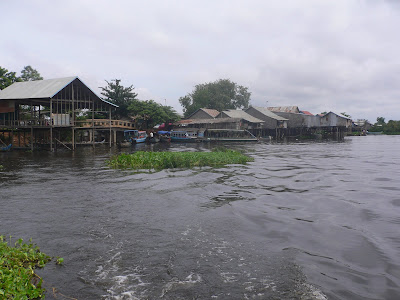During our trip to Siem Reap, we had a wonderful opportunity to go out to a village on the Tonle Sap Great Lake to see how people live there. We went by boat with a large family group of Cambodians, plus a Dutch couple and a Swiss couple who were visiting Cambodia. Because we were travelling with the Cambodian family, we went to places that see very few tourists and where the way of life is genuinely Cambodian.
First, though, we should put a few things in context. You probably know that the Mekong is one of the biggest rivers on Earth. It's about 2,900 miles (4,600 kilometres) long. Its headwaters are on the Tibetan plateau and it and its tributaries flow through China, Myanmar (Burma), Thailand, Laos, Cambodia and Viet Nam before flowing out into the South China Sea. The Tonle Sap is one of its tributaries. At its lowest flow, the Mekong discharges 16,000 cubic metres every second. At its peak in the rainy season, that rises to 40,000 - 2½ times as much. Just for comparison, the River Thames discharges 65 cubic metres per second. No, that's not a typo, 65 compared to 40,000. In the rainy season, its level rises to 50 feet (15 metres) higher than during the dry season. As you've probably guessed, that means it floods.
At its peak, the flooding inundates a huge area of Cambodia. But the story of Tonle Sap lake is particularly interesting. The headwaters of the Tonle Sap river are in the hils of western Cambodia and Thailand. It forms a large lake of about 1,000 square miles (2,600 square kilometres) in the centre of Cambodia before flowing on to join the Mekong at Phnom Penh. The picture below shows where the rivers merge: the Tonle Sap is in the foreground and the main channel of the Mekong in the background. The low-lying spit of land on the left is what divides them. This picture was taken in the dry season, with the rivers at their lowest.
However, during the rainy season, the level of the Mekong gets so high that the Tonle Sap can no longer discharge and its flow reverses. Rather like a backed up drain (but somewhat bigger), water from the Mekong flows back up the Tonle Sap to the lake, which increases to four times its original size: 4,000 square miles (10,400 square kilometres). That's just over half the size of Wales.
So it was onto this small puddle that we set forth...
... in the middle of the rainy season.

The only way to get around on the lake is by boat. You have to navigate around the clumps of water hyacinth that grow everywhere, and also try to avoid hitting the treetops that stick up out of the water. Mind you, not hitting the ones that are just below the water is more tricky.
On the lake, villagers have two choices: build your village on stilts anything up to 10 metres (30 feet) high,

or just float the whole village.

Either option brings a few challenges. On land, keeping pigs isn't much of a problem.

But try it when your house is perched on top of poles and the ground they're resting on is under 25 feet of water.

Or when your pig farm is actually a boat.

There are some islands of dry land in the lake. In the dry season, they are hills.

These islands form busy hubs of activity, where all traffic is by boat.

They are where you will find the markets,

village halls,

and temples.

The islands are also where the villagers keep their ceremonial boats. Every year, when the flow of the Tonle Sap reverses to normal, a huge festival is held in Phnom Penh. All the villages race their boats against each other down the river, and VSO also enters a team each year. So far, the only time the VSO team hasn't come last is the year when the boat sank. This year's water festival is in November, so the embarrassing pictures should be here some time after that.

But most of the people on the lake live not on the islands but in the stilted villages. In some areas, the houses form streets and the whole thing feels extraordinarily like the Grand Canal in Venice.

The villagers do everything with their homes that land-dewllers do. They have restaurants, bars, shops, farms and even flower gardens. This is the family home that we went to for lunch.

And this is their farm: a fish farm.

The houses are entirely made of wood and are very open. Even the floors are made of slats with gaps between them that drop straight down to the water. Not only does this keep them wonderfully cool, it also makes sweeping the floor nice and easy. Here, some of the family members are preparing lunch.

After lunch, all of Cambodia goes to sleep for about an hour. This is the view out of the back door.

And this is the view from the back door looking in.

But then the villages come back to life, people go back to work...

.. and the kids start playing.

Because it was the last day of the Pchum Ben festival, this particular afternoon was something special. From about 3 o'clock on, more and more boats started appearing on the lake, racing each other up and down.

As we went out and joined them, it became clear what was going on. It was one great big, rioutous, joyful water fight! Everyone had come armed with small plastic bags that they were filling with lake water and hurling at each other as they went along. The idea seemed to be to sneak up blindside as fast as you could, soak the other boat and then try to get away before they could retaliate. One boat had a great trick of looking like it had lost power until another was just in range...

What was really special was that the villagers appeared to love the fact that barangs were joining in the fun. Unfortunately, we weren't armed so were something of a soft target. Some of us tried to hide behind umbrellas but we all got soaked: none more so than Perry, uncompetitive as ever, who was hanging out right off the boat trying to catch the bags that were being thrown at him so that he could throw them back. He caught precisely zero.

But the soaking didn't matter at all. It was just a wonderful experience, full of shared fun and laughter. We even saw Lypeng on another boat, waving madly as he recognised us. But all too soon, it was time to go yet again so we set off back to the shore.

I'll bet none of you have got a trip on Tonle Sap lake on the last day of Pchum Ben down on your bucket list. You should have - it's an experience of a lifetime.
More soon. In the meantime, please don't forget the need to keep supporting VSO through our Justgiving page at www.justgiving.com/jagoteers.





No comments:
Post a Comment